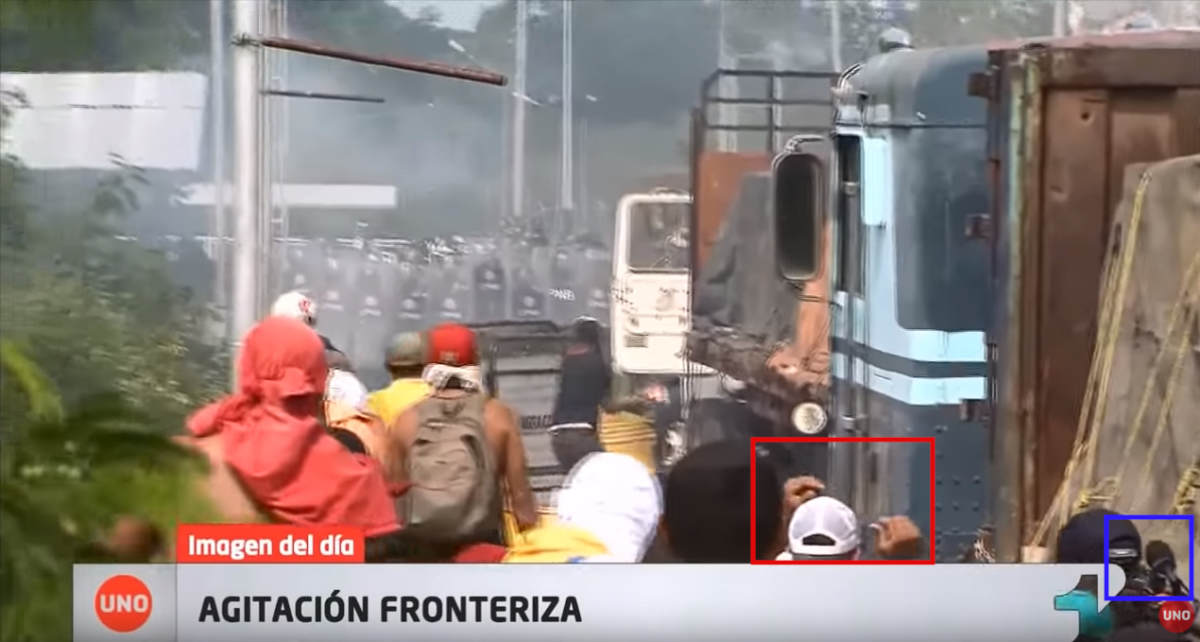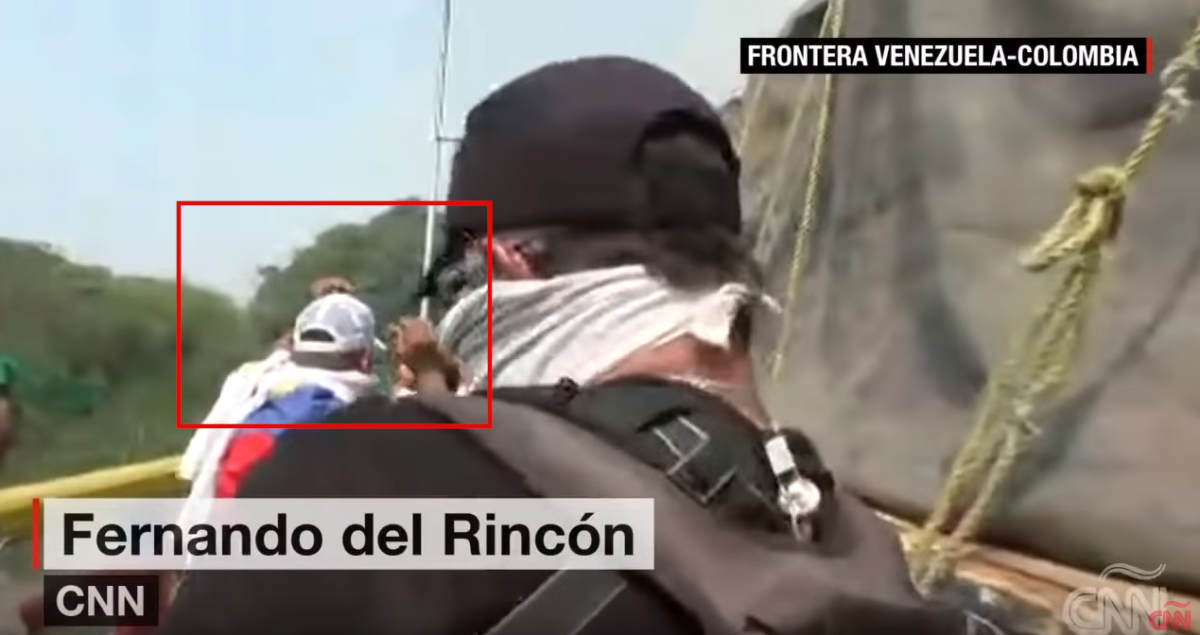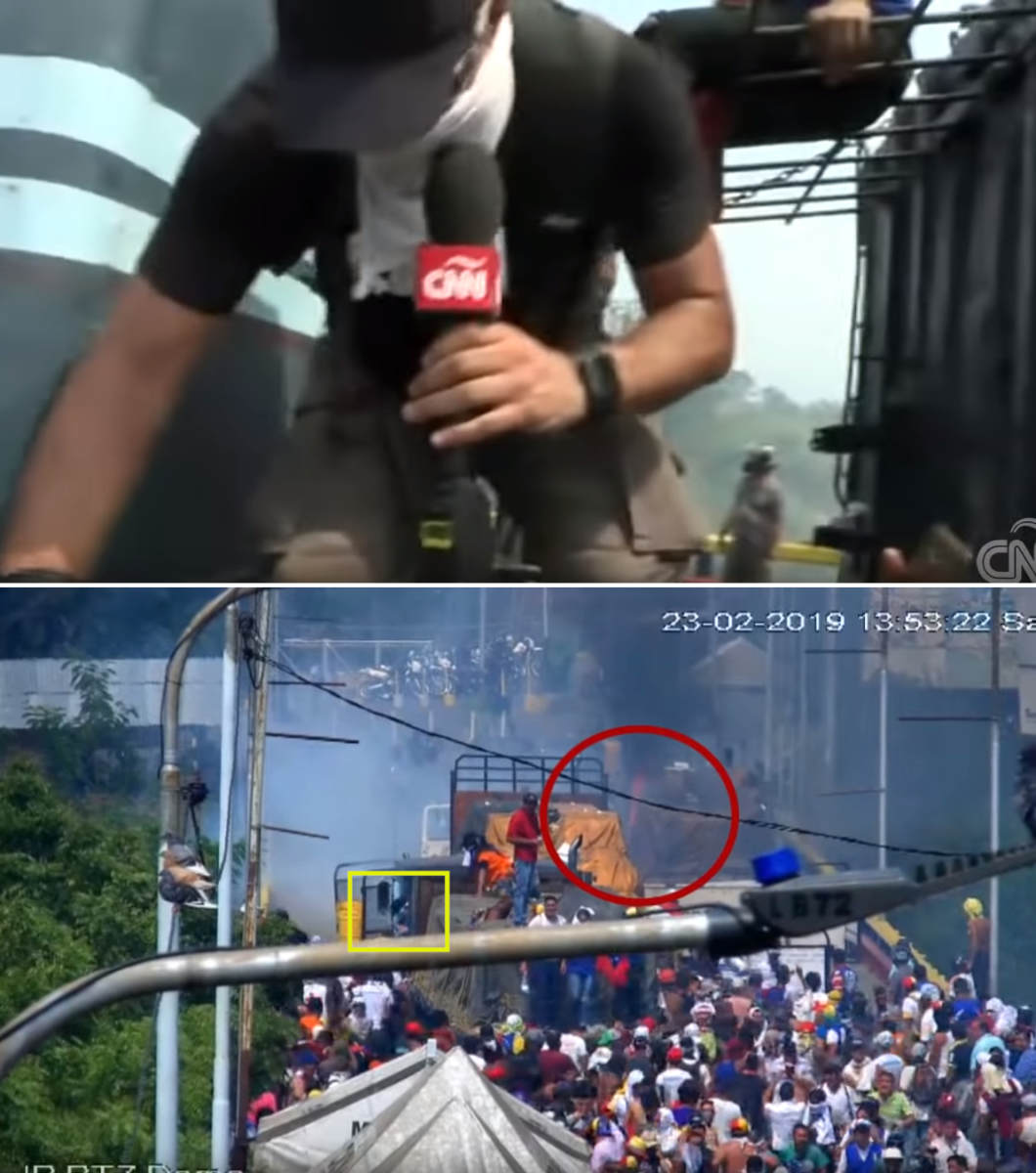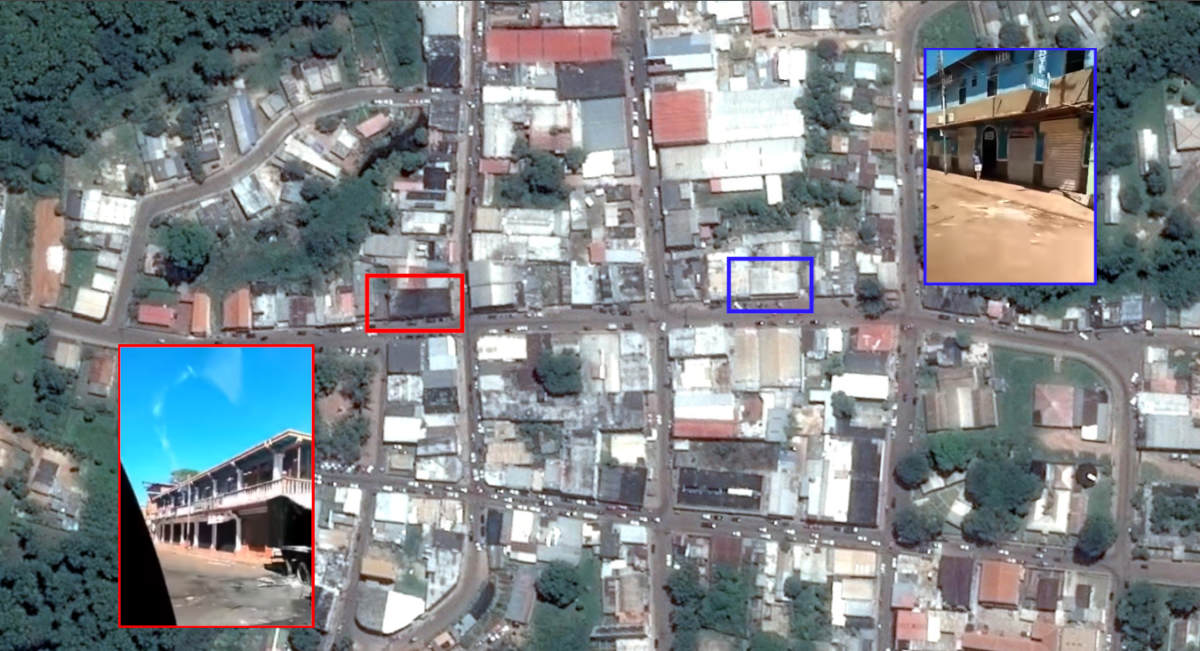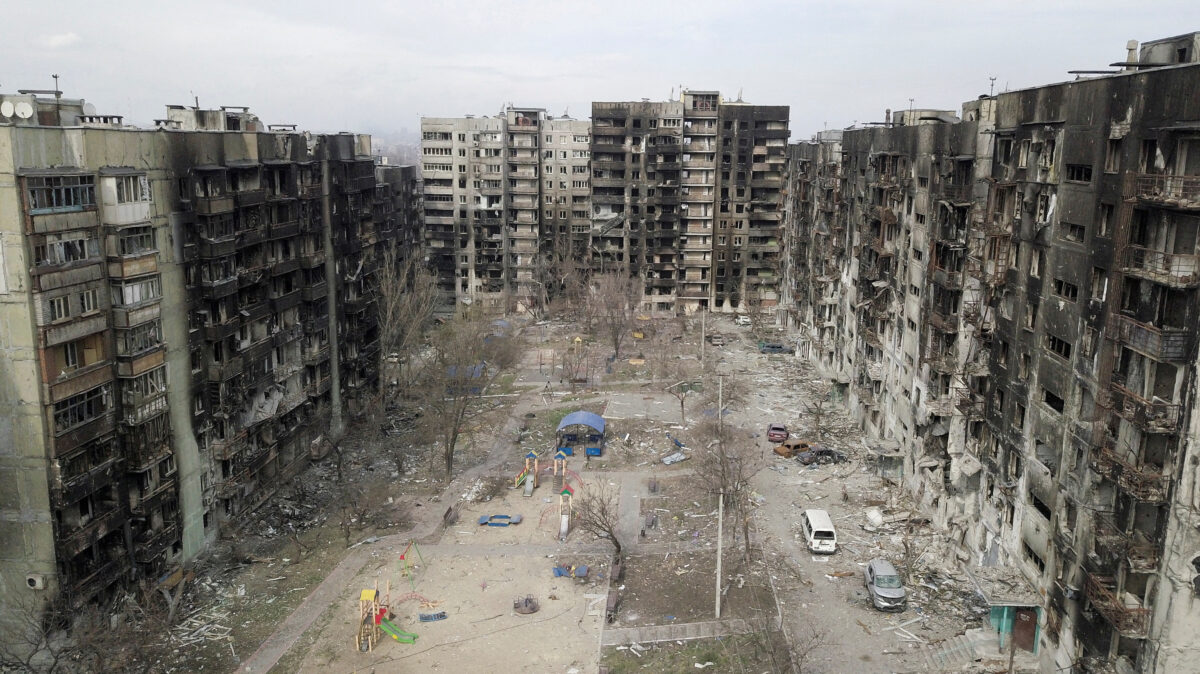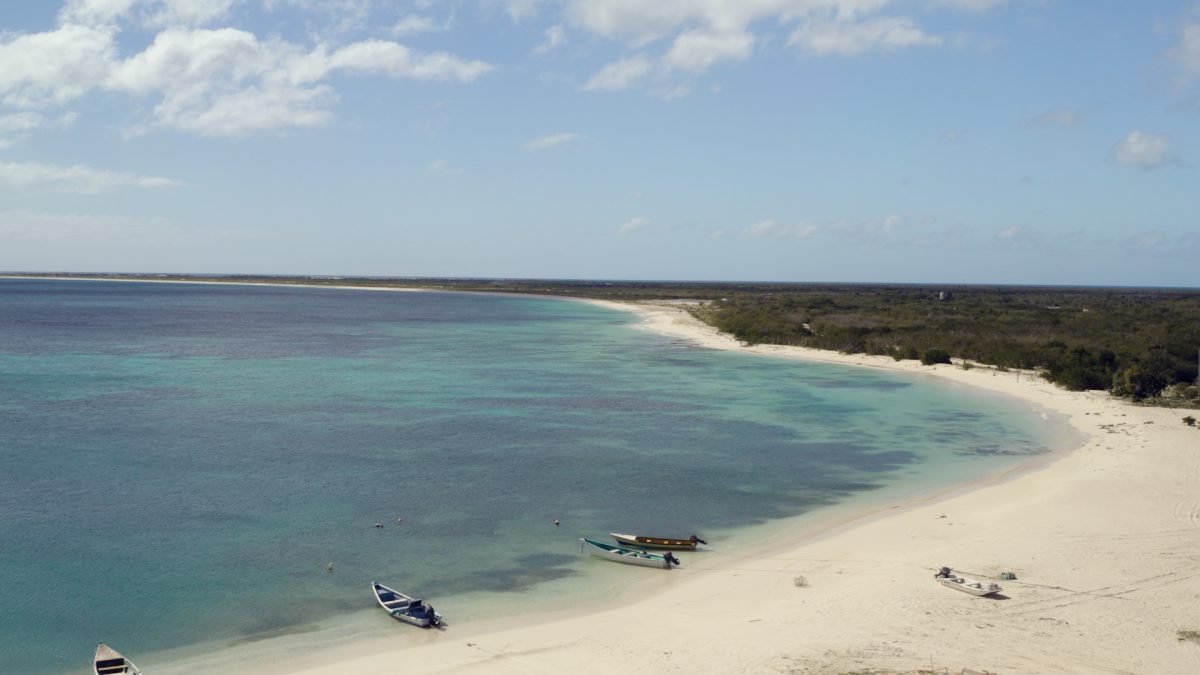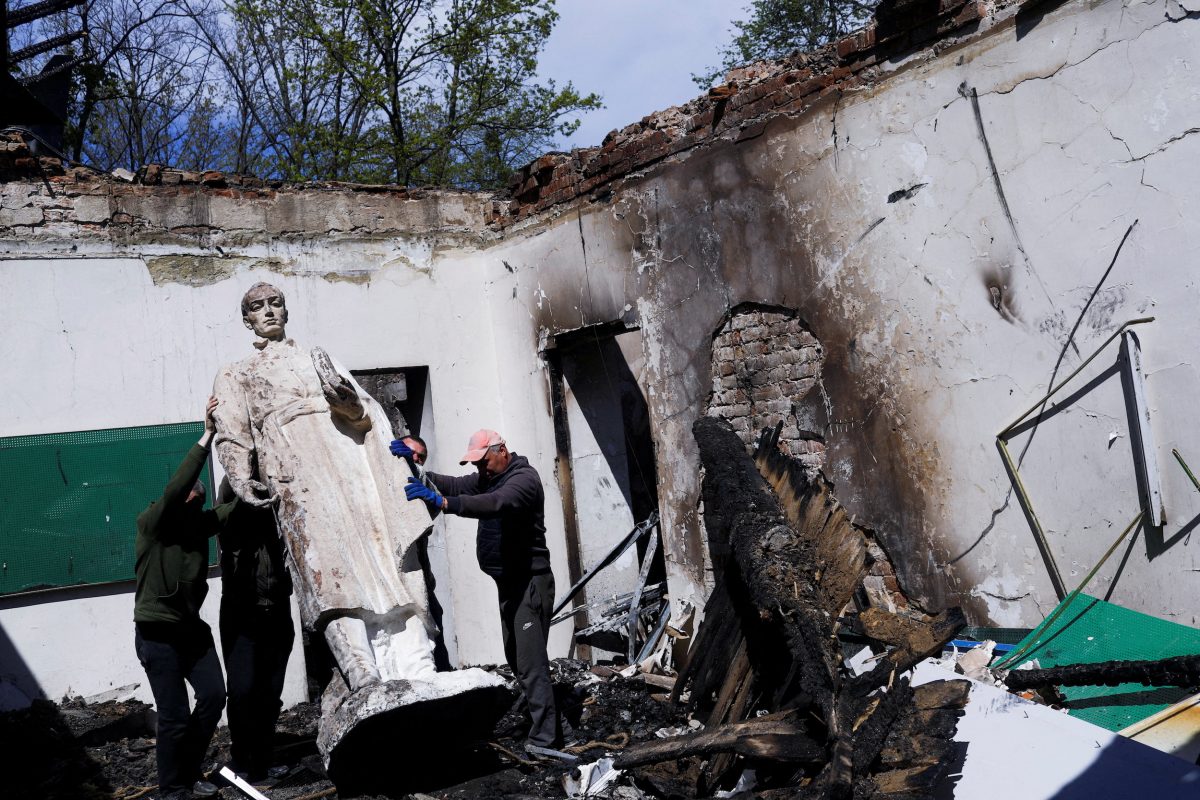Fire on the Border: Analyzing Venezuela’s February 23 Border Clashes
On Saturday February 23 2019, hundreds of volunteers and political activists hoped to deliver over 600 tonnes of humanitarian aid into Venezuela on two bridges connecting Colombia’s Norte de Santander department with Venezuela’s Táchira state, and a road connecting Roraima and Bolívar states in Brazil and Venezuela, respectively. The highly anticipated event was part of an unfolding political showdown between the government of president Nicolás Maduro and the Venezuelan opposition, led by the partially-recognized interim president Juan Guaidó.
In the weeks leading up to the event, the Maduro government made it abundantly clear that the aid would not be allowed into the country. For the opposition’s gambit to work, the Venezuelan authorities posted to the border would have to defy orders from Caracas and let the aid in.
By nightfall on February 23, four people were dead and hundreds were injured; Colombian authorities claimed that at least 60 Venezuelan soldiers and police had defected into Colombia, and none of the aid trucks had successfully reached their targets inside Venezuela. The turmoil reached its climax on the Francisco de Paula Santander International Bridge as two of the aid trucks were engulfed in flames amid clashes between Venezuelan authorities and demonstrators throughout that afternoon.
The events of February 23 developed across several sites on both sides of Venezuela’s border with Colombia and Brazil. This article will focus on four of those sites: the town of Ureña, the Francisco de Paula Santander bridge, the Simon Bolívar bridge, and city of Santa Elena de Uairén.
The Aid Effort in Context
The attempted aid delivery took place during an unprecedented time in Venezuelan history.
Considering the May 20 2018 presidential election to be illegitimate, the opposition-controlled National Assembly announced on January 5 of this year that it would not swear-in president Maduro to his second term in an event that should have taken place on January 10. On January 15, it formally declared that President Maduro had “usurped” power; then, on January 23, National Assembly president Juan Guaidó assumed the presidency of the country on an interim basis, leaving Venezuela with two heads of state.
Following Guaidó’s landmark January 23 declaration, the opposition began to concertize plans to stage an international humanitarian relief operation, which the United States quickly came to spearhead. On January 25, the White House appointed Elliott Abrams as its Special Envoy for Venezuela. In a move emblematic of the deep political rift in Venezuela, the Maduro government reacted by publicizing its own relief efforts, and received 7.5 tonnes of medical supplies from Russia through the World Health Organization (WHO) on February 21.
As the United States government began to fly aid into Colombia, Maduro made several statements to the media to the effect that Venezuelans did not need the aid because they “are not beggars”, and that he considered the aid to be “a message of humiliation” from the White House. Maduro also said in televised comments that the aid consisted of “rotten and contaminated” food and suggested the relief campaign was an opposition excuse to “hand over” Venezuela to the United States.
On February 22, Maduro ordered the closure of three bridges connecting Colombia’s Norte de Santander department with Venezuela’s Táchira state, as well as the border crossing with Brazil. By the time that the aid trucks started on their journey on the morning of February 23, all of their most likely routes into Venezuela were closed.
Ureña
Starting in the early morning hours of February 23, anti-government protesters and National Bolivarian Guard (NBG) soldiers began to clash in the city of Ureña, located on the border with Colombia in Venezuela’s Táchira state. Ureña is connected to the city of Cúcuta by the Santander bridge. The two cities are located on opposite sides of the Táchira river, which acts as the border between Venezuela and Colombia in that area.
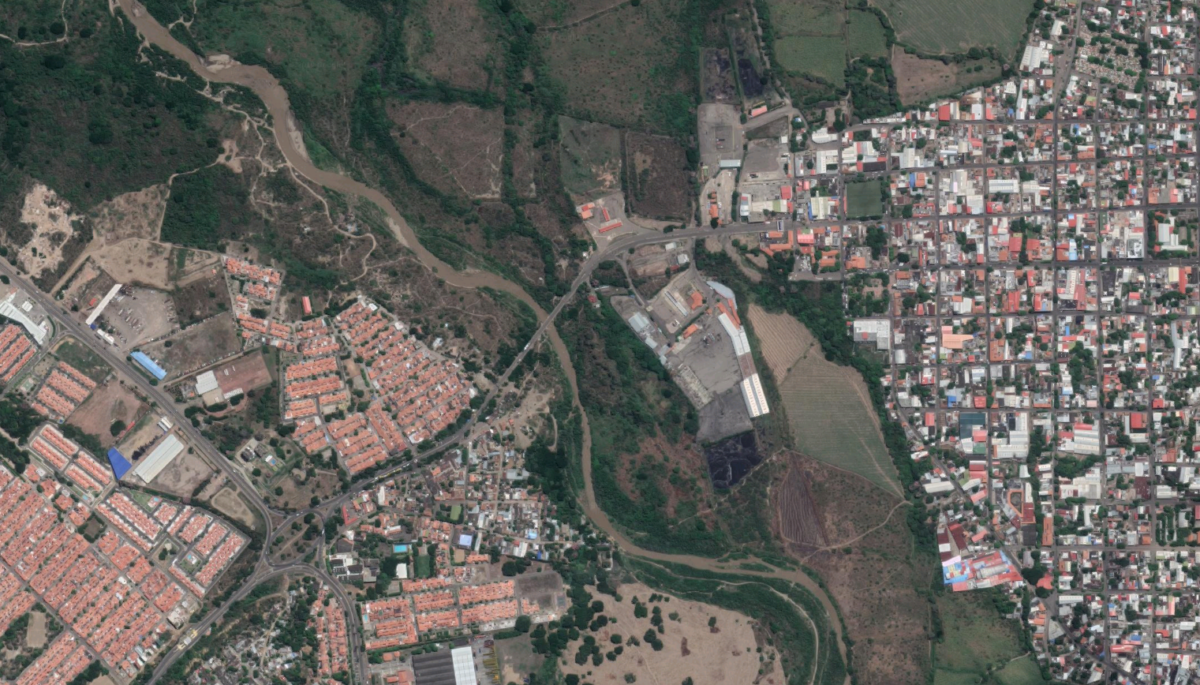
Cúcuta on the left and Ureña on the right. The Táchira river separates the two countries. The Santander Bridge, located in the centre of the image, connects the two cities (Source: Google/Digital Globe):
Some of the most intense clashes took place on a three-block section of road that runs east from Venezuelan customs. There, NBG soldiers fired tear gas at the protesters who were attempting to clear a way through to the Colombian border located a short distance away to allow the aid into Venezuela. Some of these clashes were captured on video by film crews who broadcast live from the town throughout much of the morning.
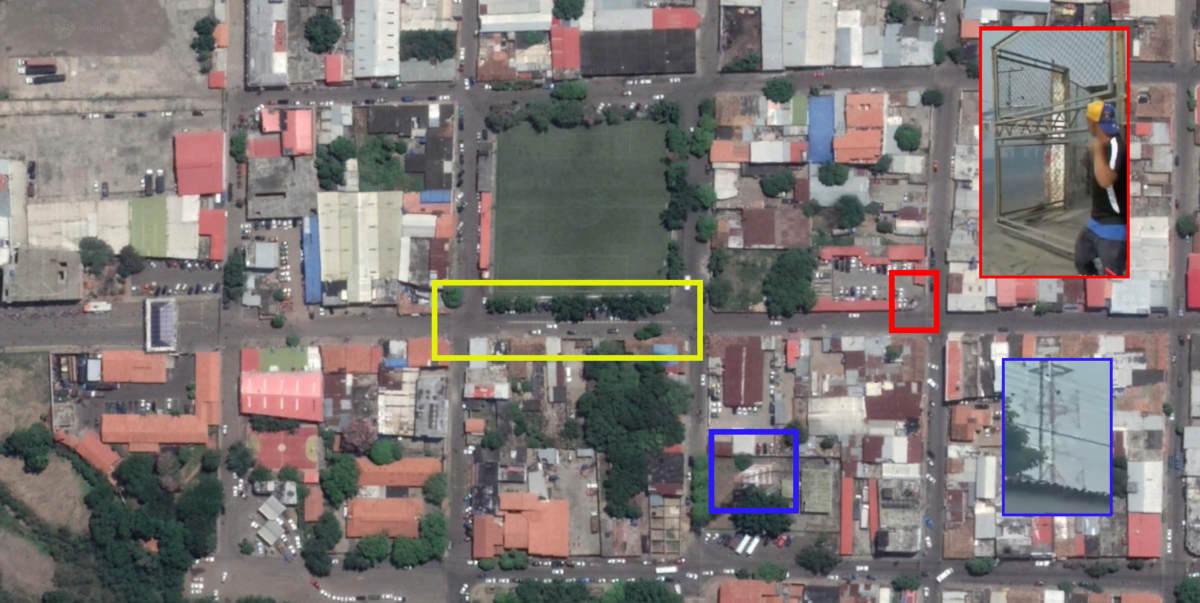
The street area where the clashes took place in Ureña, using a live feed from Global News for reference (source). The yellow box represents the approximate location of the NGB positions throughout the day (Satellite imagery courtesy of Google/Digital Globe):
At one point in the morning, protesters took control of a Táchira state bus and began to push it towards the National Guard soldier barricaded located towards Venezuelan customs:
MORE: Activists hijack a bus in Ureña as clashes continue over the Maduro administration's closing of the Venezuelan border #tictocnews pic.twitter.com/LhGcS3IvVY
— Bloomberg QuickTake (@QuickTake) February 23, 2019
The protesters also took control of a second bus for the same purpose. After setting the bus on fire, some of the protesters attempted to push it down the road towards the NBG line, but lost control of the vehicle and crashed it into a building:
MORE: The bus activists hijacked was set on fire as protests continue to turn violent in Ureña #tictocnews pic.twitter.com/aKm2B5xQph
— Bloomberg QuickTake (@QuickTake) February 23, 2019
At least twenty people were injured in the clashes in Ureña during the day’s clashes.
Santander Bridge
On the opposite side of the Táchira river, approximately one kilometer away from where the clashes in Ureña were taking place, one of the convoys attempted to drive across the Francisco de Paula Santander International Bridge shortly before 1:00 PM local time. The convoy was made up of four tractor-trailers.
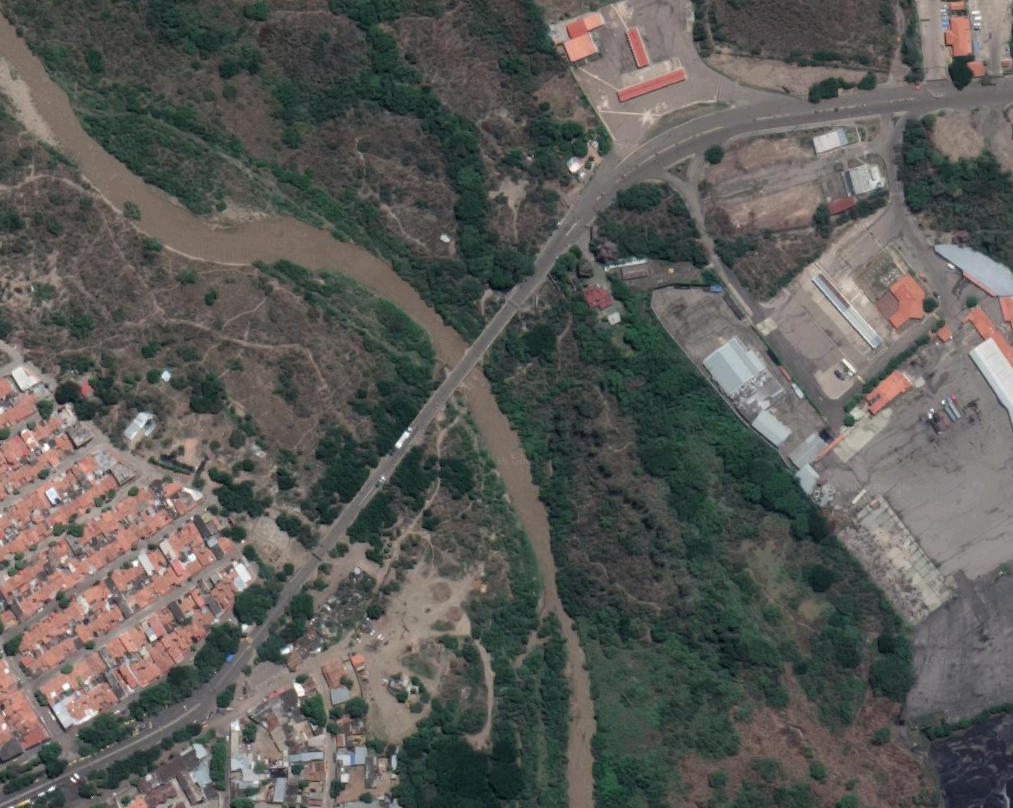
Satellite image of the Santander bridge connecting Venezuela and Colombia (Source: Google/Digital Globe)
The bridge had been heavily barricaded by Venezuelan authorities anticipating the attempted aid delivery. In the video below, the activists are attempting to convince the National Bolivarian Police (NBP) officers on the bridge to led the convoy through:
AHORA / Desde Puente internacional Francisco de Paula Santander en #Ureña el oficla a cargo de la Policía Nacional Bolivariana solicita tiempo para dar respuesta al paso de #AyudaHumanitaria para #Venezuela #23Feb @ReporteYa pic.twitter.com/2ABHHQy9xv
— Obeysser Prada T (@ObeysserPrada) February 23, 2019
Overwhelmed by the large crowd, the NBP officers were forced to withdraw from their position on the bridge. As the activists advanced, they removed barricades from the bridge:
#ATENCIÓN Momento en que la Policía Nacional cede a la presión ciudadana en el puente Ureña en la frontera colombo / venezolana este #23Feb pic.twitter.com/c5YFJkfJO4
— NTN24 Venezuela (@NTN24ve) February 23, 2019
The NBP formed a line on the Venezuelan side of the bridge to prevent the trucks from entering the country. The trucks remained on the bridge as confrontations between demonstrators and the NBP erupted, and began to cross towards Venezuela at approximately 12:48 PM local time.
The CCTV footage below was captured by a Colombian camera looking east across the bridge. It captured the moment that the convoy first came under tear gas fire from the NBP, sending the people who were riding on the vehicles scrambling for safety:
#Colombia border security footages shows #Venezuela riot police firing tear gas at the Francisco de Paula Santander bridge forcing those trying to enter with humanitarian aid to retreat from the convoys. pic.twitter.com/HNsVIZd27c
— Kejal પ્રવીણ Vyas (@kejalvyas) February 23, 2019
At this point, three of the four trucks were caught in a no-man’s-land between the NBP and the protesters, while the rear truck remained surrounded by protesters. As pointed out by the Colombian fact-checking organization Colombia Check, the three leading trucks crossed the border into Venezuela.
As the afternoon progressed and the confrontation on the bridge raged, one of the trucks caught fire. The fire would eventually spread to a second truck. Initial reports from the scene suggested that the fire was caused by a tear gas canister fired by the Venezuelan authorities. There are media reports of tear gas canisters starting fires, and a canister was recorded starting a fire in a field just north of the Simon Bolívar bridge that same day (5:10:30 to 5:11:13 in this video).
The open source evidence examined for this article is not complete: it does not show the moment of ignition. For this reason, it is not possible to make a definitive determination regarding the cause of the fire. However, the available evidence does suggest the possibility that the fire was started when a Molotov cocktail thrown by a man at the police missed its mark.
A trio of videos recorded from three different vantage points on and near the Santander bridge allowed us to create a timeline of the minutes leading up to and following the start of the fire.
A camera crew with Colombia’s Noticias Uno captured the moment that a man threw two Molotov cocktails at the NBP. In the clip below, notice that the first Molotov flies in a line towards the police, while the second flies off at an angle off to his right:
Note that on the bottom right of the Noticias Uno clip there is a man with a white hat who raises his hands in the air in surprise (highlighted in red) at seeing the man throw the first Molotov cocktail. Note also that slightly behind and to the right of the man in the white hat is a microphone (highlighted in blue):
The microphone belongs to the cameraperson that was on the bridge with CNN En Español’s Fernando Del Rincón. Footage taken by Del Rincón’s cameraperson captured the same instant that the man in the white hat raises his hands in surprise (highlighted in red):
The footage from CNN En Español goes on to show Del Rincón climb onto a blue truck, and after a short period of time climb back down to go inspect the fire, which had by that point drawn the attention of the crowd.
A third camera was trained on the Santander bridge when the fire started, this one belonging to a closed-circuit television (CCTV) system operated by the Colombian authorities. The CCTV footage captured the moment that Del Rincón climbed down from the blue truck to go take a closer look at the fire:
By syncing these three videos—the one from Noticias Uno, the one from CNN en Español’s Fernando Del Rincón, and the one from CCTV camera—we are able to estimate that the suspect Molotov cocktail was thrown at approximately 1:52:24 PM local time, according to the timestamp on the CCTV footage.
These are the steps that we followed to make this determination:
- The man in the white hat raises his hands in surprise when the first Molotov cocktail is thrown at 0:16 in the Noticias Uno video.
- The man with the white hat raises his hands in surprise in the CNN En Español video at 0:01. Del Rincón climbs down from the blue truck fifty-nine seconds later.
- According to the timestamp on the CCTV video, Del Rincón climbs down from the truck at 13:53:23 PM. The suspect Molotov thrown fifty-nine seconds earlier, at approximately 1:52:24 PM local time.
Below, the three videos synced up:
According to the video’s timestamp, the flames on the burning truck are first visible in the CCTV footage at 1:52:57 PM. As the flames appear, a man standing on the back of the burning truck takes cover by ducking.
Crucially, the CCTV footage cuts off at 1:39:17 PM and does not re-start until 1:52:45 PM, twenty-one seconds after the man on the bridge threw the suspect Molotov cocktail. The fact that these twenty-one seconds of footage are missing are the reason why we cannot point conclusively to the Molotov cocktail as the cause of the fire.
Bellingcat reached out to Colombia’s migration authority to request the uncut footage, but did not receive a response prior to publication.
The CCTV footage did capture the moment that the same man threw a Molotov cocktail at the police approximately twenty minutes earlier, at 1:32:38 PM. That Molotov also missed its mark, and appears to have hit the top of one of the trucks. The flames were quickly extinguished, suggesting that the Molotov impacted the metallic roof of the vehicle:
The burning of the aid trucks sparked heated debate both in Venezuela and abroad, with both the government and the opposition blaming one another for intentionally setting the trucks ablaze. While the open source information currently available does not allow for a definitive determination of who or what started the fire, it does point to the possibility that the blaze was caused by a Molotov cocktail thrown at the NBP that missed its target and instead landed on or near the truck that caught fire.
Simon Bolívar Bridge
The Simon Bolívar International bridge connects Cúcuta with the city of San Antonio del Táchira in Venezuela, and has become synonymous with the Venezuelan exodus as it is frequently used as an exit point for migrants leaving the country.
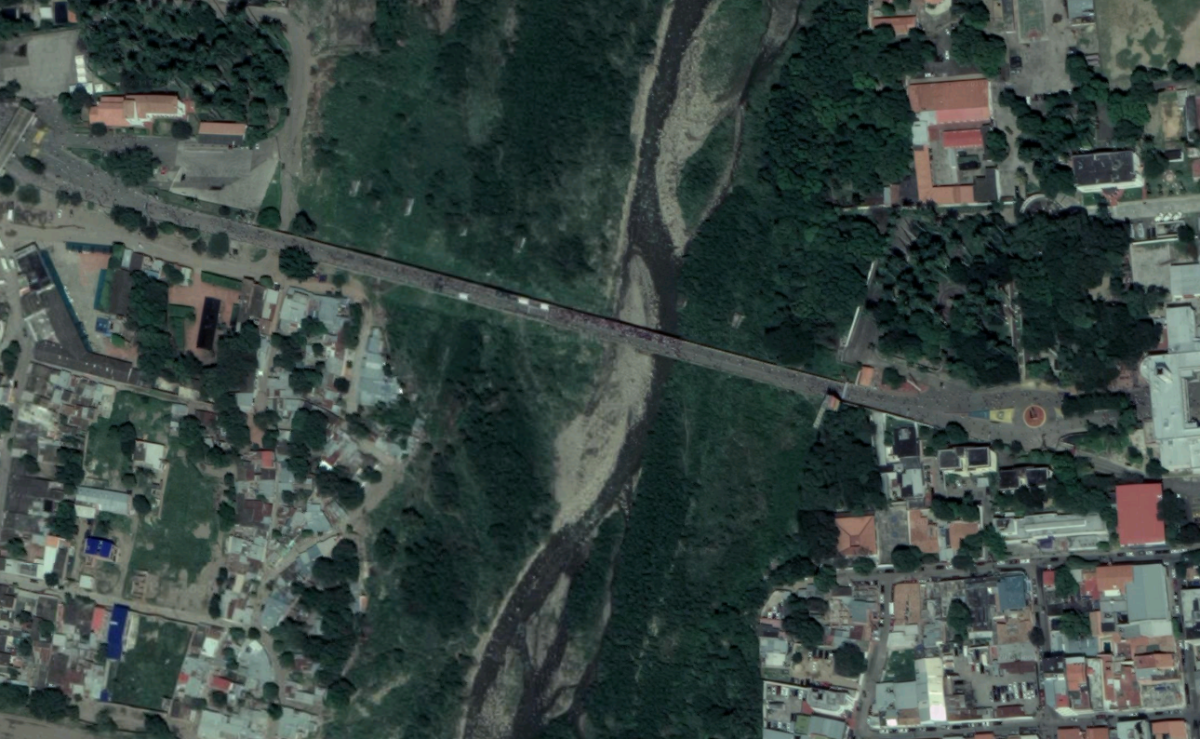
Satellite image showing the Simon Bolívar Bridge over the Táchira river, which serves as the border between Colombia (left of the river) and Venezuela (right of the river) (Image courtesy of Google/Digital Globe):
The bridge was the scene of several defections by Venezuelan army and police officers throughout the day. The first defections took place shortly after dawn, when two Norinco VN-4 armoured vehicles belonging to the National Guard sped towards the Colombian side of the bridge. Aboard the vehicles were three National Guard soldiers.
The lead vehicle drove into some barricades that had been erected earlier by Venezuelan authorities. A group of people who were standing on the bridge were sent scrambling, and at least one woman received a serious injury to her head:
VIDEO: Watch as three Venezuelan troops use their jeep to smash through a security barrier, on the Simon Bolivar bridge, as they desert to neighbouring Colombia pic.twitter.com/xNpbIv0yYo
— AFP news agency (@AFP) February 23, 2019
After the soldiers surrendered their weapons, they were walked into Colombia by the authorities:
Estos serían los 3 militares q rompieron las barreras en el Pte Internacional Simón Bolívar y desertaron hacia el lado colombiano. 1 primer teniente y 2 sargentos pic.twitter.com/VbDfvKkPa2
— Roman Camacho (@RCamachoVzla) February 23, 2019
In the late afternoon, another defection involving three National Guard soldiers was caught on video. In the video, the three soldiers run onto the Colombian side of the bridge. One of them is raising his weapon—likely a rubber pellet shotgun—into the air as he runs into a waiting crowd of protesters. While some of the protesters hit the one of the soldiers, the majority of the group appears to welcome the defectors:
#ATENCIÓN Momento en que deserta otro Guardia Nacional en la fronera colombo venezolana #23feb pic.twitter.com/q4lB6bm7Ju
— NTN24 Venezuela (@NTN24ve) February 23, 2019
By the end of the day, Colombian authorities claimed that at least 60 National Guard and National Bolivarian Police officers had defected from Venezuela.
Santa Elena de Uairén
Unlike the confrontations that shook the border with Colombia, the ones near the border with Brazil turned deadly. In the city of Santa Elena de Uairén, NBG soldiers clashed with anti-government demonstrators who had mobilized in support of the aid convoy that was expected to enter the country from the Pacaraima border crossing, located some ten kilometers south of the city.
By the end of the day, at least three anti-government demonstrators had been killed and two dozen people had been injured.
Some of the clashes in the city were filmed by local residents. The video below captured part of a chase involving three NBG Norinco VN-4 armoured vehicles and a truck. At the 1:00 minute mark, the man recording video says that the “they” (the NBG soldiers) have killed the driver of truck:
As evidenced by the blue sign that appears in the video, the footage was recorded from inside a hotel called “La Abuela”. A Google Maps search for the business, corroborated by footage recorded on the same street the following week, allow for the hotel’s geolocation:
A video likely recorded just around the corner from the La Abuela hotel captured the moment that a group of residents carried a man suffering from serious head trauma down the street:
Reports of at least one dead in Santa Elena de Uairen, Venezuela, after violent clashes between anti-government protestors and Venezuelan security forces. Lots of videos circulating of different incidents of violence happening now in Venezuela. https://t.co/X9PAPsoDHj
— Eva Golinger (@evagolinger) February 23, 2019
Further south, at the Pacaraima border crossing, a National Guard unit faced off against demonstrators who had gathered to—like their counterparts on the Colombia-Venezuela border—open a path for the humanitarian aid.
A local journalist recorded the scene there from this vantage point:
Protesters and NGB soldiers squared off on the border line between Brazil in Venezuela, which is marked by a small monument located here and seen in the footage below:
#ÚLTIMO Manifestantes en territorio brasileño entraron en enfrentamiento con miembros de la Guardia Nacional Bolivariana (GNB) en la frontera entre Pacaraima y Santa Elena de Uairén. (Vía @EstadaoInter)
— Andrews Abreu (@AndrewsAbreu) February 23, 2019
The convoy that attempted to drive into Venezuela through the Pacaraima border was much smaller than its counterpart in Colombia. Here, a small truck carrying aid is escorted to the Venezuelan border by two Brazilian police vehicles:
Chegada de uma de nossas escoltas à cidade de Pacaraima (RR), fronteira com a Venezuela, para distribuição de alimentos para povo irmão venezuelano. Brasil solidário. pic.twitter.com/Ki2A4agYay
— PRF Brasil (@PRFBrasil) February 23, 2019
Conclusion
The events of February 23 threatened to push the years-long conflict between the government of president Maduro and the Venezuelan opposition closer to the abyss of armed struggle. Both sides were quick to use the burning of the aid trucks as ammunition against the other, hoping to capitalize on the event before the flames on the Santander bridge were quenched. To add to the tension, a new factor is now at play: the active interest that the international community—and in particular the United States—has in the Venezuelan crisis.
While not definitive given the available evidence, our analysis of the burning of the aid trucks on the Santander bridge nevertheless adds detail to the event beyond the political rhetoric that saturated the media in the days after the fire.
High profile events like those that drew world attention on Venezuela’s borders with Colombia and Brazil on February 23 have the capacity to precipitate policy decisions at the national level which could have severe consequences. Open source evidence like that analyzed in this article has the potential to bring some level of clarity to what may at first appear to be a hopelessly chaotic event, and in so doing provide vital information in situations that demand it.
This article was written alongside Jake Godin from Newsy.
Bellingcat’s research for this publication was supported by PAX for Peace.
